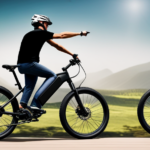Picture yourself cruising through the urban streets, smoothly gliding on the energy of an electric bike. However, what if your battery unexpectedly drains, leaving you stuck? It’s a scenario every cyclist dreads.
That’s why understanding the lifespan of an electric bike battery is crucial. In this article, I will delve into the technical aspects of battery chemistry, explore the different types of electric bike batteries, and provide valuable insights into factors that affect battery lifespan.
So buckle up, fellow cyclists, and let’s embark on this electrifying journey!
Key Takeaways
- The lifespan of an electric bike battery is influenced by factors such as battery chemistry, usage patterns, temperature conditions, and charging and discharging cycles.
- Battery degradation occurs over time, and it can be affected by the type of battery and whether it is OEM or aftermarket.
- Upgrading to higher capacity batteries may be a consideration for extending the lifespan of an electric bike battery.
- Proper battery maintenance, including avoiding extreme temperature conditions and conserving battery power, can help prolong the lifespan of an electric bike battery.
Understanding Battery Chemistry
You need to understand the battery chemistry of an electric bike to determine its lifespan.
Battery chemistry research and advancements in battery technology have greatly improved the performance and longevity of electric bike batteries.
The most common type of battery used in electric bikes is the lithium-ion battery. These batteries are known for their high energy density, long cycle life, and low self-discharge rate. They use lithium ions to transfer energy between the positive and negative electrodes.
Other types of batteries, such as nickel-metal hydride and lead-acid, are less commonly used due to their lower energy density and shorter lifespan.
Understanding the different types of electric bike batteries and their chemistry is crucial in determining how long the battery will last and how well it will perform.
Now, let’s explore the different types of electric bike batteries.
Types of Electric Bike Batteries
When it comes to the different kinds of e-bike batteries, they vary in terms of their duration. The lifespan of an electric bike battery depends on its battery technology and battery capacity.
There are several types of electric bike batteries available in the market, such as lithium-ion, lithium-polymer, and nickel-metal hydride (NiMH) batteries. Lithium-ion batteries are the most common and offer a good balance between weight, capacity, and lifespan. They have a typical lifespan of 2 to 4 years or around 500 to 1000 charge cycles.
On the other hand, lithium-polymer batteries have a similar lifespan but can be shaped in different ways, allowing for more design flexibility. NiMH batteries have a shorter lifespan of 2 to 3 years or around 300 to 500 charge cycles.
Factors affecting battery lifespan include temperature, charging habits, and overall usage. Transitioning into the subsequent section, it is important to understand these factors to maximize the lifespan of an electric bike battery without compromising its performance.
Factors Affecting Battery Lifespan
Usage patterns, temperature conditions, and charging and discharging cycles are three key factors that can affect the lifespan of an electric bike battery.
How often and how intensively the battery is used, as well as the frequency and duration of charging and discharging cycles, can have a significant impact on its overall longevity.
Additionally, extreme temperature conditions, such as excessive heat or cold, can also contribute to the degradation of the battery over time.
Therefore, understanding and managing these factors is crucial in prolonging the lifespan of an electric bike battery.
Usage Patterns
To maximize the lifespan of your electric bike battery, it’s important to consider your usage patterns. Battery capacity and battery health are directly influenced by how you use your electric bike. Frequent deep discharges and overcharging can degrade the battery capacity over time. It is recommended to avoid completely draining the battery and charging it to full capacity every time. Instead, maintaining a regular charging routine where the battery is kept between 20-80% can help prolong its lifespan.
Additionally, avoiding extreme temperature conditions, such as extreme cold or heat, can also contribute to the longevity of your battery. By being mindful of your usage patterns and following these guidelines, you can ensure that your electric bike battery lasts longer and performs optimally.
Transitioning into the subsequent section about ‘temperature conditions’, it is also important to consider how temperature affects battery lifespan.
Temperature Conditions
Maintaining optimal temperature conditions is crucial for maximizing the longevity and performance of your e-bike’s power source. When it comes to battery storage, extreme temperatures can have a significant impact on its lifespan.
High temperatures, for instance, can accelerate the degradation process and reduce the overall capacity of the battery. On the other hand, extremely cold temperatures can cause the battery to lose its power quickly. Additionally, humidity can also affect the battery’s performance. Excessive moisture can lead to corrosion and damage the internal components of the battery.
To ensure the longevity of your electric bike’s battery, it is essential to store it in a cool and dry environment. This will help preserve its capacity and extend its overall lifespan.
Moving on to the next section about charging and discharging cycles, it is important to understand the impact of these cycles on the battery’s health.
Charging and Discharging Cycles
Optimal charging and discharging cycles are crucial for maximizing the performance of your e-bike’s power source. Regularly charging and discharging your e-bike battery within the recommended limits helps to maintain its overall health and longevity. Understanding battery reconditioning and battery capacity degradation is essential for the lifespan of an electric bike battery. By following the manufacturer’s guidelines for charging and discharging, you can extend the lifespan of your battery and ensure it performs optimally.
It is important to avoid overcharging or completely draining the battery, as both practices can lead to accelerated capacity degradation. Proper battery maintenance plays a vital role in this process, and I will discuss it in the next section.
Proper Battery Maintenance
You should regularly charge your electric bike battery to ensure its longevity. Proper battery maintenance is crucial for optimizing the lifespan of your battery and avoiding common battery problems.
To help you with this, here’s a battery maintenance checklist:
- Keep your battery clean and dry to prevent moisture damage.
- Store your battery in a cool and stable environment to avoid extreme temperatures.
- Avoid overcharging or undercharging your battery, as it can affect its overall capacity.
By following these guidelines, you can significantly extend the lifespan of your electric bike battery and minimize the risk of encountering common battery problems.
Now, let’s move on to the next section about charging best practices, which will further enhance your battery’s performance and overall longevity.
Charging Best Practices
Now that we understand the importance of proper battery maintenance, let’s delve into charging best practices for electric bike batteries.
Following battery charging guidelines is crucial in optimizing charging efficiency and ensuring the longevity of your battery. To start, it’s recommended to use the charger provided by the manufacturer, as it’s specifically designed for your battery.
Additionally, it’s advisable to charge your battery at room temperature, as extreme temperatures can negatively impact the charging process. Avoid charging your battery to 100% unless necessary, as keeping it at a slightly lower charge level can help extend its lifespan.
Lastly, it’s important to periodically balance the battery cells to maintain their equal charge levels.
By adhering to these charging best practices, you can maximize the lifespan of your electric bike battery.
Now, let’s move on to exploring battery management systems.
Battery Management Systems
To effectively manage your battery, it is important to understand the role of Battery Management Systems (BMS).
A BMS is a crucial component in electric bike batteries as it helps monitor and control various aspects of battery performance. One of its key functions is to ensure the longevity of the battery by managing its capacity and preventing battery degradation.
It does this by monitoring the battery’s state of charge, temperature, and voltage levels. By carefully regulating these parameters, the BMS helps maintain optimal battery health and maximizes its lifespan.
However, despite the BMS’s best efforts, battery degradation is inevitable over time. As the battery ages, its capacity gradually decreases, leading to reduced range and performance.
When the battery’s capacity becomes insufficient, it may be time to consider battery replacement options.
Battery Replacement Options
When it comes to replacing your electric bike battery, you have a few options to consider.
One option is choosing between OEM (Original Equipment Manufacturer) batteries and aftermarket batteries. OEM batteries are made by the same company that made your electric bike, ensuring compatibility and reliability.
However, aftermarket batteries may offer more affordable options and potentially higher capacity for longer rides.
Additionally, cost considerations are important when deciding on a replacement battery, as OEM batteries tend to be more expensive than aftermarket options.
Lastly, upgrading to a higher capacity battery can provide you with increased range and performance, but it’s important to make sure it is compatible with your electric bike.
OEM vs. Aftermarket Batteries
If you’re considering an electric bike battery, you’ll want to know the difference between OEM and aftermarket options. OEM stands for Original Equipment Manufacturer, which means that the battery was made by the same company that manufactured the bike. Aftermarket batteries, on the other hand, are produced by third-party manufacturers. While aftermarket battery options may be cheaper, there are several benefits of choosing OEM batteries. They are specifically designed to fit your bike, ensuring optimal performance and compatibility. OEM batteries also often come with warranties, providing peace of mind and protection in case of any issues. Additionally, using an OEM battery can help maintain the overall value and integrity of your electric bike. When considering battery replacement options, it’s important to weigh the cost considerations as well.
Cost Considerations
Considering the cost of replacement, it is important to take into account the warranty and overall value of OEM batteries.
When it comes to battery replacement cost, OEM batteries may seem more expensive upfront compared to aftermarket options. However, they often come with longer warranties and higher overall value.
Keep in mind that the lifespan of an electric bike battery is an important factor to consider. Although aftermarket batteries may be more affordable initially, they may not last as long as OEM batteries. This means that you may end up needing to replace them more frequently, resulting in higher long-term costs.
Therefore, it is crucial to weigh the battery lifespan against the initial investment to make an informed decision.
Upgrading to higher capacity batteries can be a viable solution for those seeking longer battery life and improved performance.
Upgrading to Higher Capacity Batteries
To improve your electric bike’s performance and extend its range, upgrading to a higher capacity battery is a viable solution. When comparing battery capacities, it is important to consider the amp-hour (Ah) rating. Higher capacity batteries have larger Ah ratings, which means they can store more energy and provide longer ride times.
The benefits of upgrading to a higher capacity battery include increased range, improved hill climbing capability, and better overall performance. With a higher capacity battery, you can go on longer rides without worrying about running out of power. Additionally, the upgrade allows for a more efficient use of the battery’s charge, resulting in a longer lifespan for the battery itself.
By upgrading to a higher capacity battery, you can enjoy extended rides and maximize the lifespan of your electric bike’s battery. This leads us to the next section, where we will discuss how to extend the battery’s lifespan.
Extending Battery Lifespan
To extend the lifespan of an electric bike battery, it’s important to avoid subjecting it to extreme temperature conditions, such as extreme heat or cold. These conditions can significantly impact the performance and longevity of the battery.
Conserving battery power by using efficient riding techniques and minimizing unnecessary power drain can also help prolong its lifespan.
Lastly, utilizing the pedal assist mode can help reduce the strain on the battery by utilizing the rider’s own energy, making it an excellent option for extending the battery’s lifespan.
Avoiding Extreme Temperature Conditions
Avoiding extreme temperature conditions can help extend the lifespan of an electric bike battery. Here are three key ways to avoid such conditions:
-
Avoid overcharging: Overcharging can lead to excessive heat buildup, which can degrade the battery’s performance and lifespan. It is important to unplug the charger once the battery is fully charged to prevent overcharging.
-
Be mindful of battery age: As batteries age, they become more sensitive to extreme temperatures. Avoid exposing the battery to extremely hot or cold temperatures, as it can cause irreversible damage and reduce its overall lifespan.
-
Store in optimal conditions: When not in use, store the electric bike and its battery in a cool and dry place. Extreme temperatures, such as those in a hot garage or under direct sunlight, can accelerate battery degradation.
By following these guidelines, you can maximize the lifespan of your electric bike battery and ensure optimal performance.
Conserving battery power is another important aspect to consider, which will be discussed in the next section.
Conserving Battery Power
One way to conserve battery power is by adjusting the bike’s power assist level. By selecting a lower power assist level, the battery usage can be reduced, allowing for a longer ride before recharging is necessary.
Additionally, using battery saving techniques such as avoiding rapid acceleration and maintaining a steady speed can also help to conserve battery power. Energy efficient riding techniques, such as pedaling along with the motor, can further extend the battery life. This involves using pedal assist mode, which combines the rider’s pedaling power with the electric motor’s assistance.
By utilizing these techniques, riders can maximize the efficiency of their electric bike’s battery and enjoy longer rides without the need for frequent recharging.
Using Pedal Assist Mode
Using pedal assist mode can greatly extend the range of your e-bike. Pedal assist mode allows you to utilize the battery capacity more efficiently, as it provides additional power to assist your pedaling. This means that you can cover longer distances without draining the battery as quickly.
By using the pedal assist mode, you are able to optimize the energy efficiency of your e-bike and get the most out of your battery. It’s important to note that the energy consumption will vary depending on factors such as terrain, rider weight, and riding style. However, overall, using pedal assist mode can help conserve battery power and allow you to go further on a single charge.
Now, let’s debunk some common myths about battery lifespan.
Battery Lifespan Myths Debunked
To get the most out of your electric bike battery, you’ll want to understand the common myths surrounding battery lifespan. There are many misconceptions about how long an electric bike battery can last and what actions can affect its longevity. Let’s debunk some of these battery lifespan myths and learn about common battery maintenance mistakes.
| Myth | Fact | Solution |
|---|---|---|
| Leaving the battery on the charger overnight will damage it | Modern chargers have built-in mechanisms to prevent overcharging | It is safe to leave the battery on the charger |
| Fully discharging the battery before recharging will improve its lifespan | Lithium-ion batteries prefer shallow discharges and frequent top-ups | Recharge your battery after each ride, regardless of its current charge level |
| Cold weather has no impact on battery performance | Cold temperatures can temporarily reduce the battery’s capacity | Store the battery in a warm place during winter months |
Understanding these battery lifespan misconceptions and avoiding common maintenance mistakes will help you optimize your electric bike battery’s lifespan. Now let’s transition into the subsequent section about recycling and disposal of electric bike batteries.
Recycling and Disposal of Electric Bike Batteries
Make sure you are aware of the proper methods for recycling and disposing of your electric bike batteries.
When it comes to recycling methods, there are a few options available. The first is to check with your local recycling center to see if they accept electric bike batteries. They may have specific guidelines for how to properly dispose of them.
Another option is to contact the manufacturer of your electric bike. They may have a program in place for recycling their batteries.
It’s important to recycle your electric bike batteries because of their environmental impact. Batteries contain toxic chemicals that can seep into the soil and water if not disposed of properly. By recycling them, we can reduce the amount of waste and minimize harm to the environment.
Understanding battery warranty is the next step in ensuring the longevity of your electric bike battery.
Understanding Battery Warranty
When it comes to understanding battery warranties for electric bikes, there are two key points to consider: coverage and limitations.
The coverage aspect refers to what specific components and issues are included in the warranty, such as defects or premature wear.
On the other hand, limitations outline any restrictions or conditions that may void the warranty, such as improper use or unauthorized modifications.
Additionally, some manufacturers offer extended warranty options for those who want extra protection beyond the standard coverage period.
Coverage and Limitations
You can expect the lifespan of an electric bike battery to vary depending on the coverage and limitations.
Battery replacement is a common concern for electric bike owners, but the warranty can provide some peace of mind. Most electric bike batteries come with a warranty that covers a specific period of time or a certain number of charge cycles. However, it’s important to understand the limitations of the warranty.
For example, it may only cover manufacturing defects and not normal wear and tear. Additionally, some warranties may require the battery to be used and stored in specific conditions to remain valid. Understanding the coverage and limitations of the battery warranty is crucial in order to make informed decisions about battery replacement and maintenance.
Moving on to extended warranty options, there are additional plans available that can provide even more protection and coverage for your electric bike battery.
Extended Warranty Options
Consider exploring extended warranty options to provide additional protection and coverage for your investment. When it comes to battery warranty coverage, an extended warranty can offer peace of mind and financial security. It ensures that if any issues arise with your electric bike battery within the specified period, you will receive repairs or a replacement at no additional cost. The benefits of an extended warranty go beyond just the coverage itself. It also often includes additional perks such as priority service, expedited shipping, and access to exclusive discounts. By investing in an extended warranty, you are safeguarding your electric bike battery and maximizing its lifespan. Next, we will explore troubleshooting battery issues and how to resolve them efficiently.
Troubleshooting Battery Issues
If my electric bike battery is experiencing issues, it’s important to troubleshoot them to ensure optimal performance. Battery troubleshooting is crucial to identify and address common battery issues.
One common issue is a sudden decrease in battery range, which could indicate a problem with the battery or the charging system. In such cases, checking the battery connections, inspecting for any physical damage, and ensuring proper charging techniques can help resolve the issue.
Another common problem is a battery that doesn’t hold a charge, which might be caused by a faulty charger or a worn-out battery. By testing the charger and considering a battery replacement if necessary, this issue can be resolved.
It’s crucial to address these battery issues promptly to maintain the overall performance of the electric bike.
Now, let’s move on to battery safety tips.
Battery Safety Tips
When it comes to battery safety for electric bikes, there are two important aspects to consider: handling and storage precautions, as well as charging safety measures.
In terms of handling and storage, it is crucial to avoid dropping or exposing the battery to extreme temperatures, as these can cause damage or even lead to a fire. Additionally, it is essential to store the battery in a cool and dry place to prevent any potential hazards.
When it comes to charging, it is important to use the charger specifically designed for your electric bike battery, and to never leave the battery unattended while charging to avoid any potential risks.
Handling and Storage Precautions
To prolong the lifespan of your electric bike battery, make sure you properly handle and store it. Here are three key tips to keep in mind:
-
Proper handling during transportation: When moving your electric bike or battery, ensure it is securely fastened and protected from any impacts or jolts. Avoid dropping or mishandling the battery, as this can damage its internal components and reduce its overall lifespan.
-
Storage conditions and precautions: When not in use, store your electric bike battery in a cool and dry place, away from direct sunlight and extreme temperatures. Avoid storing it in areas with high humidity or where moisture can accumulate, as this can lead to corrosion and potential damage to the battery.
-
Battery maintenance: Regularly inspect the battery for any signs of wear or damage. Ensure the battery contacts are clean and free from dirt or debris. Additionally, charge the battery to around 50% before long-term storage to prevent over-discharge or overcharging.
By following these handling and storage precautions, you can maximize the lifespan of your electric bike battery.
Now, let’s move on to discussing charging safety measures.
Charging Safety Measures
To ensure the safety of charging your electric bike, it is important to follow specific measures.
First and foremost, always use the charger provided by the manufacturer, as using an incompatible charger can damage the battery. Additionally, avoid overcharging by monitoring the charging time closely and disconnecting the charger once the battery is fully charged. Overcharging can reduce battery capacity and shorten its lifespan.
It is also crucial to charge the battery in a well-ventilated area to prevent overheating. Lastly, avoid charging the battery in extreme temperatures, as this can negatively impact its performance and overall lifespan.
By following these charging safety measures, you can maximize battery performance and prolong its longevity.
Transitioning to the subsequent section about maximizing battery performance with accessories, it is important to consider additional ways to optimize your electric bike’s battery.
Maximize Battery Performance with Accessories
You can maximize your electric bike battery performance by using accessories. Accessories such as a battery bag or case can protect your battery from extreme temperatures and physical damage, which can help prolong its lifespan. Additionally, using a battery charger with a built-in voltage regulator can optimize battery performance by providing a steady and controlled charge.
To further maximize battery efficiency, consider using a battery management system (BMS) that monitors and balances the individual cell voltages, ensuring each cell is charged and discharged evenly. This helps prevent overcharging and undercharging, which can degrade the battery over time.
Another accessory that can enhance battery performance is a power meter or display. This allows you to monitor your battery’s charge level and adjust your riding style or route accordingly, preventing sudden battery drain and prolonging your ride.
In conclusion, with the right accessories, you can maximize battery performance, optimizing its efficiency and extending its lifespan.
Conclusion: Enjoying Long-lasting Battery Power
Make the most of your rides by ensuring your battery has long-lasting power. Proper battery storage and charging techniques are essential for maximizing the lifespan of your electric bike battery.
When storing your battery, make sure it is kept in a cool and dry place, away from extreme temperatures and direct sunlight. It is also important to avoid fully depleting the battery before recharging it. Instead, try to maintain a charge level between 20% and 80% for optimal battery health.
Regularly charging your battery, even if you’re not using it, can help maintain its performance. When charging, use the appropriate charger provided by the manufacturer and avoid using fast chargers that can potentially damage the battery.
By following these battery storage and charging techniques, you can enjoy long-lasting power and maximize the lifespan of your electric bike battery.
Frequently Asked Questions
Can an electric bike battery be recharged before it is completely drained?
Yes, electric bike batteries can be recharged before they are completely drained. However, overcharging can lead to reduced battery life. If not fully charged, the battery may not provide optimal performance and may have a shorter overall lifespan.
Are there any specific storage requirements for electric bike batteries?
There are specific storage requirements for electric bike batteries. Extreme temperatures, both hot and cold, can have a significant impact on the lifespan of the battery. Proper storage in a cool and dry place is recommended.
How long does it take to fully charge an electric bike battery?
Charging time for an electric bike battery can vary depending on several factors. These include the battery capacity, charger output, and charging method. It typically takes anywhere from 2 to 6 hours to fully charge an electric bike battery.
Can I use a different charger than the one provided with my electric bike battery?
Yes, you can use compatible chargers. However, it is important to ensure they are appropriate for your electric bike battery. Alternative charging methods can be used, but it’s best to consult the manufacturer for guidance.
Are there any safety precautions I should take when handling or storing an electric bike battery?
When it comes to handling and storing an electric bike battery, it is important to take safety precautions. This includes avoiding extreme temperatures, keeping it away from flammable materials, and using the proper storage container.
Conclusion
In conclusion, the lifespan of an electric bike battery depends on various factors. These factors include the type of battery and how it is maintained and charged. By understanding the chemistry behind batteries and implementing proper maintenance practices, we can ensure a long-lasting battery power for our electric bikes.
Just like a well-tuned engine propels a car forward, a well-maintained battery fuels our electric bikes. It propels us effortlessly through the wind, up steep hills, and across long distances. So, let’s take care of our batteries and enjoy the endless adventures they can offer.
















